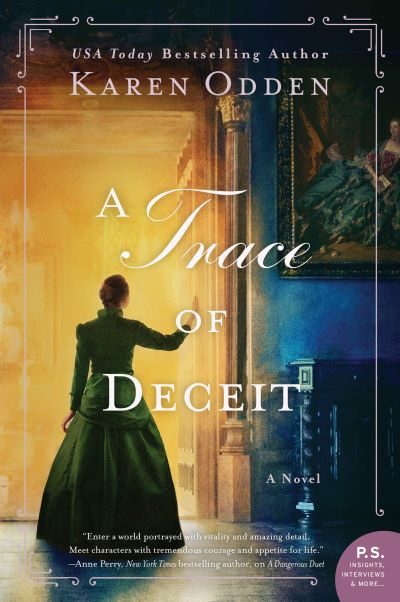I asked Karen Odden, author of the Victorian mysteries A DANGEROUS DUET (2018) and A TRACE OF DECEIT (2019) about the differences between historical mystery and straight historical fiction. Here's what she had to say!
Wednesday, September 30, 2020
Guest Post by Karen Odden: The “Mysnomer” in the Label “Historical Mystery”
Tuesday, September 29, 2020
Review: A TRACE OF DECEIT by Karen Odden
I've never been a reader of mysteries, but Karen Odden is turning me into one! I read Karen's first Victorian Mystery, A DANGEROUS DUET (William Morrow, 2018) and fell in love with the novel's feisty protagonist, intriguing plot, and convincing Victorian world. Odden's second Victorian Mystery, loosely connected to the first, is even better: A TRACE OF DECEIT (William Morrow, 2019) delves into the dark world of art forgery and auction house corruption as a young female artist struggles to solve her brother's murder and clear his name.

A Trace of Deceit by Karen Odden
My Review
About the Author
Karen Odden received her Ph.D. in English literature from New York University and taught at the University of Wisconsin-Milwaukee. She has contributed essays and chapters to books and journals, including Studies in the Novel, the Journal of Victorian Culture, and Victorian Crime, Madness, and Sensation; she has written introductions for Barnes and Noble editions of books by Dickens and Trollope; and she edited for the academic journal Victorian Literature and Culture. She freely admits she might be more at home in nineteenth-century London than today, especially when she tries to do anything complicated on her iPhone. Her first novel, A Lady in the Smoke, was a USA Today bestseller and won the New Mexico-Arizona 2016 Book Award for e-Book Fiction. Her second novel, A Dangerous Duet, about a young pianist who stumbles on a notorious crime ring while playing in a Soho music hall in 1870s London, won the New Mexico-Arizona 2019 Book Award for Best Historical Fiction. A Trace of Deceit is her third novel. She resides in Arizona with her family and a ridiculously cute beagle named Rosy.Website | Facebook | Twitter | Pinterest | BookBub | Goodreads
Blog Tour Schedule
Monday, September 7 Review at Books and Backroads Review at WTF Are You Reading? Tuesday, September 8 Feature at I'm All About Books Wednesday, September 9 Review at Hallie Reads Thursday, September 10 Review at Gwendalyn's Books Friday, September 11 Review at Historical Fiction with Spirit Monday, September 14 Review at Pursuing Stacie Tuesday, September 15 Review at Faery Tales Are Real Wednesday, September 16 Review at Into the Hall of Books Thursday, September 17 Review at Novels Alive Friday, September 18 Review at A Darn Good Read Saturday, September 19 Review at Nursebookie Monday, September 21 Review at Books and Zebras Tuesday, September 22 Review at Passages to the Past Thursday, September 24 Guest Post at Novels Alive Friday, September 25 Review at The Lit Bitch Monday, September 28 Review at Amy's Booket List Review at Chicks, Rogues, and Scandals Tuesday, September 29 Review at Impressions In Ink Review at Writing the Renaissance Wednesday, September 30 Review at Probably at the Library Guest Post at Writing the Renaissance Thursday, October 1 Excerpt at Books In Their Natural Habitat Review at History from a Woman’s Perspective Friday, October 2 Review at Jessica Belmont Review at Jorie Loves A Story Review at View from the BirdhouseGiveaway
During the Blog Tour, we are giving away one paperback copy of A Trace of Deceit! To enter, please use the Gleam form linked below. The giveaway is open to US residents only and ends on October 2nd. You must be 18 or older to enter. A Trace of DeceitMonday, September 28, 2020
Why Read Historical Fiction Set in Sixteenth Century France? Reason #3
Still looking for reasons to read or write historical fiction set in Renaissance France? Here's one sure to convince you.
Reason #3: DRAMA
There's something about Renaissance dynasty dramas that strongly appeals to modern television audiences. From 2007-2010, THE TUDORS ruled.
Then, from 2011-2013, THE BORGIAS stole the limelight.
Even the Medici have had their day (2016-2019).
Now it's time for THE VALOIS, the dynasty that ruled France throughout the sixteenth century.
The Valois (or more properly, the Valois-Angoulêmes) ruled France from 1515-1589. François I assumed the throne in 1515 and ruled for 32 years, until dying of illness in 1547. His son, Henri II, wed to Catherine de Medici, ruled from 1547-1559. Three of Henri's sons, François II (1559-60), Charles IX (1560-74), and Henri III (1574-1589), ruled in quick succession after him, all with the aid of their shrewd and crafty mother. The reigns of any of these rulers provides plenty of dramatic fodder for novels and film.
François I was only three years younger than England's infamous Henry VIII. The two kings were rivals their entire lives and even died the same year. Thanks to his obsessive wife-swapping, Henry is better known to modern audiences, but drama of all types riddled François's long reign. Highlights include:
meeting with Henry VIII at the lavish event known as the Field of Cloth of Gold in 1520, where each monarch strove to out-dazzle the other with magnificent tents, clothes, feasts, jousts and games;
Thursday, September 24, 2020
Why Read Historical Fiction Set in Sixteenth Century France? Reason #2
Yesterday, I set out to convince you why reading and writing historical fiction set in Renaissance France was a worthwhile endeavor. The first reason I offered was ESCAPE from the turbulence of our present situation. Today, I offer a second reason: RELEVANCE.
Reason #2: RELEVANCE
While reading historical novels can offer a temporary escape from the troubles of today's world, it can also serve as a means to examine issues at the forefront of our national consciousness. Despite the five hundred years that separate our two eras, today's society continues to grapple with many of the same issues that preoccupied the people of the Renaissance. In the sixteenth century, Western Europe was a world in flux, caught between a renewed appreciation of the arts and wisdom of the ancient Greeks and Romans and the new vistas offered by exploration and the expansion of trade. Although monarchy as a form of government would remain unquestioned for two more centuries, feudal society was beginning to crumble. Class boundaries were becoming more porous as court functionaries gained titles and merchants and tradespeople amassed wealth that allowed them to climb a few rungs up the social ladder. Christians called into question central tenets of the Catholic faith and the supreme authority of the Church. Women were demanding access to education and professions traditionally denied to them. The world was changing with a speed that often left people of the era breathless and unmoored--similar to the way many people feel today.
Exploration and an expansion of foreign trade brought the people of Renaissance Europe into contact with societies vastly different from their own. Just as readers of today must weigh issues of immigration and globalization, people of sixteenth century had to expand their worldview to incorporate an entire New World and the unfamiliar peoples who inhabited it. Issues of race complicated the quest for resources, as explorers and settlers subjugated and exploited native inhabitants for their own gain. The broadening of the known world affected everything from religious to social to politico-economic thought and required the adjustment of long established systems.
 |
| 1591 French map of Florida by Jacques Le Moyne de Morgues |
 |
| Portrait of an African Slave Woman by Annibale Carracci, circa 1580s |
Historical fiction that deals with exploration, such as Laila Lalami's The Moor's Account (2014) and Ronald Wright's The Gold Eaters (2016), stir a reader's imagination and conscience, providing new ways to consider the issues of racism and immigration that affect twenty-first century life.
 |
| St. Bartholomew's Massacre by François Dubois |
 |
| L'Heptameron of Marguerite de Navarre |
 |
| Louise Labé by Pierre Woeiriot |
 |
| Suzanne de Court's signature on an enameled platter |
Wednesday, September 23, 2020
Why Read Historical Fiction Set in Sixteenth Century France? 10 Reasons
In these turbulent times, as society reels from pandemic, natural disasters, and political turmoil, one might reasonably ask: "Why read historical fiction? And why, in particular, historical fiction set in sixteenth century France?" The companion question--why write it?--is one I've been contemplating as the world goes up in flames around me (I live in California, so that is not a figure of speech!). Over a series of posts, I will offer ten reasons why historical fiction set in Renaissance France is worth reading, not only for its entertainment value, but for the light it sheds on issues that continue to challenge society today.
Reason #1: ESCAPE
Reading has always been a way to escape the stresses and tension of daily life, and during the coronavirus lockdowns, people have turned to literature for a reprieve. After an initial dip, book sales are climbing steadily, with e-book sales particularly strong. Whether to distract themselves from their troubles or to enliven the boredom of being cooped up for months on end, quarantined readers are reaching for books more often than ever. Novels set in Renaissance France offer readers ample opportunity to escape the excruciating sameness of days in twenty-first century lockdown.
Do your eyes ache from staring at a computer screen for work or school? Watch journeymen printers pull pages on a Lyonnais printing press instead.
Need some exercise? Gallop through the forest as you hunt with the king.
 |
| Photo credit: Andy_Casrol |
Tired of retracing the same path through your tiny apartment? Dance a galliard in the ballroom of a sumptuous château. (Be careful not to trip as you stare up at the gorgeous ceiling!)
 |
| Photo credit: Zairon |
An engaging novel set in a long ago era has the power to remove you from your present situation for a time, providing a refuge where you can soothe your mind and regain your balance. When everyday life becomes particularly stressful, historical fiction has a distinct advantage over contemporary fiction, for it does not simply translate lived difficulties directly onto the page. Instead of reinforcing and intensifying the malaise of all-to-familiar situations, historical fiction affords a larger perspective against which current circumstances can be better judged and more easily borne.
Even as it distracts and entertains, historical fiction reminds us of a certain truth, one that brings a good measure of comfort: no matter how bad things got in the past, when plague, famine, war, and poverty had consequences far more dire than they do today, societies not only survived, but eventually prospered. Reading a historical novel interrupts the constant stream of breaking news that bombards us with catastrophe to remind us that, in all likelihood, things will turn out fine in the end.
And if we can laugh and dream and fall in love with a handsome prince along the way, all the better.
**********
Not yet convinced of the worth of Renaissance historical fiction? Be sure to return for Reason #2.















































